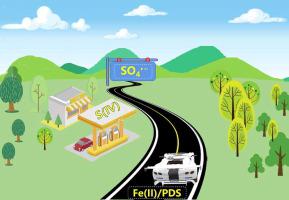Chemical Engineering Journal ( IF 13.3 ) Pub Date : 2022-06-18 , DOI: 10.1016/j.cej.2022.137625 Guang Li , Dandan Rao , Han Liu , Tianwei Hao , Jian Zhang , Bo Sun

|
The advanced oxidation processes (AOPs) with Fe(II) as homogenous activator suffer from the accumulation of insoluble Fe(III) oxides which results in the decrease of available catalyst and increase of iron sludge. Herein, with Fe(II)/peroxydisulfate (Fe(II)/PDS) process as an example, HSO3– was proposed to enhance the regeneration of Fe(II). The results showed that 250 µM of HSO3– increased the removal of benzoic acid (BA) from 18.8% to 41.3% while further increasing HSO3– dosage promoted its scavenging effects and decreased BA removal. Accordingly, multiple-dosing mode of HSO3– was used which enhanced BA removal to 63.8%. Addition of HSO3– recovered Fe(II) from Fe(III)/Fe(IV) and shifted the distribution of reactive species from Fe(IV) to SO4 −. Besides as the reductant, the reaction of HSO3– with Fe(III) and Fe(IV) severed as the AOPs and produced SO4
−. Besides as the reductant, the reaction of HSO3– with Fe(III) and Fe(IV) severed as the AOPs and produced SO4 −. A mathematic model was constructed for the Fe(II)/PDS/HSO3– process, and it revealed that ∼ 78% of dosed HSO3– was transformed to SO4
−. A mathematic model was constructed for the Fe(II)/PDS/HSO3– process, and it revealed that ∼ 78% of dosed HSO3– was transformed to SO4 −, but ∼ 81% of the generated SO4
−, but ∼ 81% of the generated SO4 − was consumed by HSO3–. The reaction of Fe(IV) with HSO3– and the activation of in situ formed peroxymonosulfate by Fe(II) are chiefly responsible for SO4
− was consumed by HSO3–. The reaction of Fe(IV) with HSO3– and the activation of in situ formed peroxymonosulfate by Fe(II) are chiefly responsible for SO4 − formation with the contributions of ∼ 47% and ∼ 27%, respectively, in the Fe(II)/PDS/HSO3– process. Considering the complexity of the multiple-dosing mode of HSO3– in the real practice, the sparingly soluble CaS2O5 which released HSO3– gradually was synthesized and used. The single dosing of CaS2O5 stood out in terms of promoting pollutant abatement by the Fe(II)/PDS process compared to that adding equivalent of HSO3–. These results will benefit the optimization of the Fe(II)-based AOPs.
− formation with the contributions of ∼ 47% and ∼ 27%, respectively, in the Fe(II)/PDS/HSO3– process. Considering the complexity of the multiple-dosing mode of HSO3– in the real practice, the sparingly soluble CaS2O5 which released HSO3– gradually was synthesized and used. The single dosing of CaS2O5 stood out in terms of promoting pollutant abatement by the Fe(II)/PDS process compared to that adding equivalent of HSO3–. These results will benefit the optimization of the Fe(II)-based AOPs.
中文翻译:

亚硫酸氢盐对 Fe(II)/过硫酸盐对污染物减排的促进作用:亚硫酸氢盐作为 FeII-(FeIII/FeIV) 回收促进剂和自由基前体的双重作用
以Fe(II)为均相活化剂的高级氧化工艺(AOPs)会因不溶性Fe(III)氧化物的积累而导致可用催化剂减少和铁泥增加。在此,以Fe(II)/过硫酸盐(Fe(II)/PDS)工艺为例,提出了HSO 3 -来增强Fe(II)的再生。结果表明,250 µM 的 HSO 3 –将苯甲酸 (BA) 的去除率从 18.8% 提高到 41.3%,同时进一步增加 HSO 3 –的用量促进了其清除效果并降低了 BA 的去除率。因此,使用了 HSO 3 –的多次给药模式,将 BA 去除率提高到 63.8%。添加 HSO 3 –从 Fe(III)/Fe(IV) 中回收 Fe(II) 并将活性物质的分布从 Fe(IV) 转移到 SO 4  -。除了作为还原剂,HSO 3 -与 Fe(III) 和 Fe(IV) 的反应作为 AOP 被切断并产生 SO 4
-。除了作为还原剂,HSO 3 -与 Fe(III) 和 Fe(IV) 的反应作为 AOP 被切断并产生 SO 4  -。为 Fe(II)/PDS/HSO 3 -过程构建了一个数学模型,结果表明,约 78% 的投加 HSO 3 -转化为 SO 4
-。为 Fe(II)/PDS/HSO 3 -过程构建了一个数学模型,结果表明,约 78% 的投加 HSO 3 -转化为 SO 4  -,但产生的约 81% 的 SO 4
-,但产生的约 81% 的 SO 4  -被消耗掉了由 HSO 3 – . Fe(IV) 与 HSO 3的反应以及原位活化Fe(II) 形成的过氧单硫酸盐主要负责 SO 4
-被消耗掉了由 HSO 3 – . Fe(IV) 与 HSO 3的反应以及原位活化Fe(II) 形成的过氧单硫酸盐主要负责 SO 4  -的形成,在 Fe(II)/PDS/HSO 3 -过程中的贡献分别约为 47% 和 27% 。考虑到HSO 3多次投药方式的复杂性——在实际应用中,逐渐合成并使用了释放HSO 3的难溶性CaS 2 O 5 。与添加当量的 HSO 3相比,CaS 2 O 5的单次投加在促进 Fe(II)/PDS 工艺的污染物减排方面表现突出——. 这些结果将有利于基于 Fe(II) 的 AOP 的优化。
-的形成,在 Fe(II)/PDS/HSO 3 -过程中的贡献分别约为 47% 和 27% 。考虑到HSO 3多次投药方式的复杂性——在实际应用中,逐渐合成并使用了释放HSO 3的难溶性CaS 2 O 5 。与添加当量的 HSO 3相比,CaS 2 O 5的单次投加在促进 Fe(II)/PDS 工艺的污染物减排方面表现突出——. 这些结果将有利于基于 Fe(II) 的 AOP 的优化。











































 京公网安备 11010802027423号
京公网安备 11010802027423号